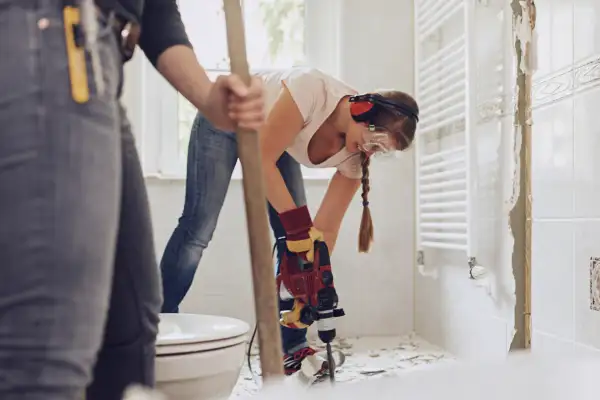Bathroom Remodels Were Incredibly Popular With Homeowners in 2020

Being cooped up indoors 24/7 has made a lot of people turn a critical eye toward their homes. While some are opting to move to new homes in more spacious locales, many homeowners are using money they’ve saved by not eating out or traveling to make their homes more comfortable.
In fact, on average Americans spent $13,000 on home projects this year — nearly 50% more than they did in 2019, according to home improvement marketplace HomeAdvisor.
Around two-thirds of that went toward renovation projects, with the rest going to maintenance or emergency repairs. Of the renovations, 30% were bathroom upgrades, making it the most popular project other than simply repainting walls.
What does a bathroom upgrade cost?
Stay-at-home and social distancing guidelines meant to control the coronavirus highlight the unique role our homes play. The home has become our office, school, entertainment center, and place of social gathering. (In family groups, smaller than ten, spread six feet apart — of course.)
Bathroom renovations have always been a popular way to make our homes more comfortable or luxurious. After all, it’s where you can take a relaxing bath after a long day or find an oasis of peace after refereeing the fifth sibling fight of the day.
According to HomeAdvisor, the national average cost to remodel a bathroom is about $9,000 — though expenses can range widely depending on how much you do and at what quality level and it's easy to go over budget.
Remodeling Magazine’s Cost vs. Value Report, pegs the cost of a mid-range bathroom remodel at around $21,000 and an upscale remodel at $67,000 or more.
Hi-tech features such as touchless faucets are becoming popular, especially now that COVID has put a premium on handwashing and avoiding contact with surfaces. These can cost from $125 to over $500 but are usually more energy and water efficient than standard faucets, which will reduce your utility bills.
Replacing a bathtub with a standing shower or increasing the size of an existing shower are also popular options. These generally cost between $250 and around $9,000, but prices vary.
Other popular bathroom fixes include changing the wall textures, improving lighting fixtures, and changing the cabinetry. All of these will have costs ranging from a few hundred dollars to several thousand dollars.
According to Mischa Fisher, chief economist at HomeAdvisor, when doing any type of home renovation you want to balance the cost, long term value, and benefit.
“Bathrooms do a really good job of striking that balance: they’re not cheap, but also not nearly as expensive as something like a kitchen remodel,” Fisher said. “They’re also highly used rooms, so, improving the aesthetics and functionality of the space can really boost the day-to-day enjoyment of your home.” (HomeAdvisor estimates a new kitchen will run between $5,000 and $45,000.)
What will the return on my bathroom investment be?
In general, upgrading an outdated bathroom will add value to your home — but not all upgrades are equal.
“From our experience, you’re going to get somewhere in the neighborhood of a 10% bump on the resale,” said Mike Petrakis, CEO of PowerPay, a lender offering home renovation financing to contractors and homeowners.
When deciding how much to invest in a bathroom makeover, you should consider the type of buyer you’ll eventually be targeting. Believe it or not, going big isn’t always the best answer.
According to Remodeling Magazine, a full mid-range bathroom remodel costing $21,000 on average will add almost $14,000 in value to your home, meaning you’ll recover 64% of your investment when you sell. By contrast, a full upscale bathroom remodel costing $67,000 will add about $38,000 in value. That means you’ll recover only about 57% of your investment.
Also consider small upgrades that may provide a better rate of return. Adding color to your bathroom is an easy fix that doesn’t cost that much but can provide a boost. For example, according to Zillow, in 2017 homes with blue bathrooms sold for an average of $5,400 more than expected.
In the end, renovating your bathroom can add value in more ways than one. As Fisher points out, “thinking about value and ROI are important, but as we’re spending more time at home than ever before, it is important to make sure that your home is a source of joy, not frustration.”
More from Money:
How to Get a Home Improvement Loan
Dreaming of a DIY Renovation? How to Remodel Without Hurting Your Pride or Property Value
